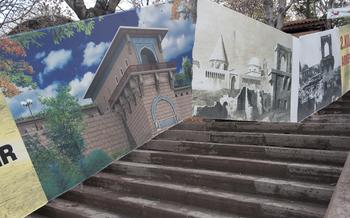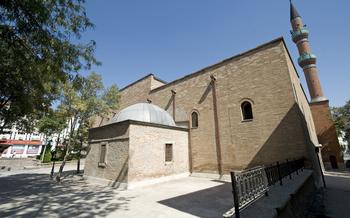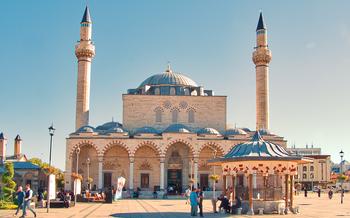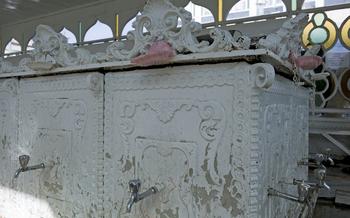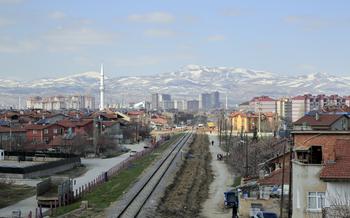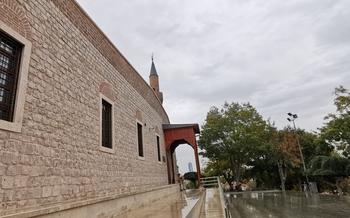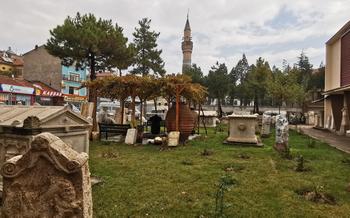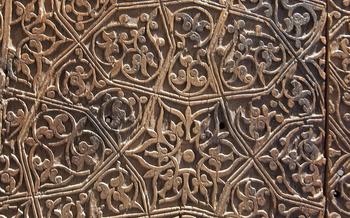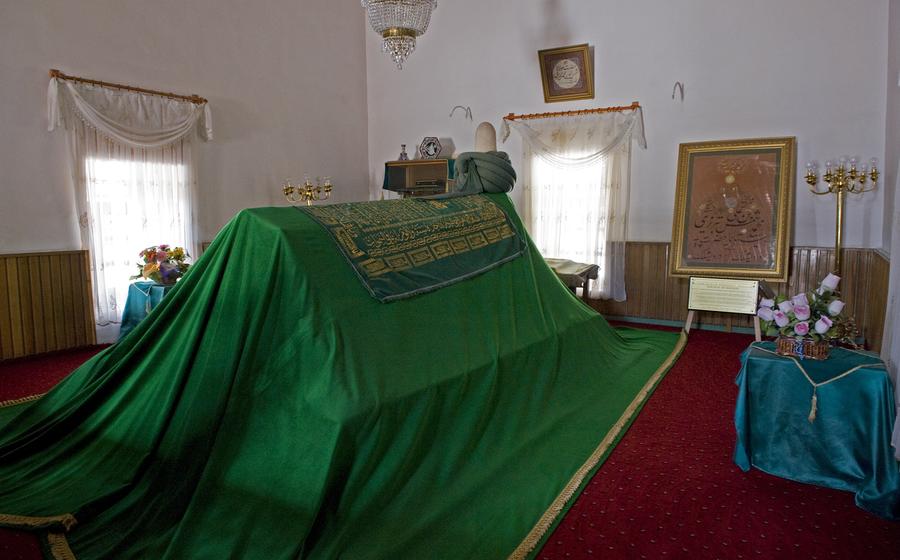
Konya Great Mosque
- Konya Great Mosque: A Majestic Symbol of Seljuk Architecture
- Exploring the Grand Courtyard: A Tranquil Oasis
- Marveling at the Prayer Hall: A Masterpiece of Islamic Art
- Unveiling the History: A Journey Through Time
- Symbolism and Spirituality: A Deeper Connection
- The Mausoleum of Rumi: A Pilgrimage Site for Seekers
- The Konya Museum: A Treasure Trove of Islamic Art
- Attend a Mevlana Festival: A Celebration of Rumi's Legacy
- Konya's Culinary Delights: A Taste of Anatolian Cuisine
- Shopping for Souvenirs: A Memento of Your Visit
- Planning Your Visit: Essential Information
- Accommodation Options: A Range of Choices
- Transportation Tips: Getting Around Konya
- Insider Tip: Discover the Hidden Gems
Konya Great Mosque: A Majestic Symbol of Seljuk Architecture
Standing tall in the heart of Konya, Turkey, the Konya Great Mosque, also known as the Alaeddin Mosque, is a magnificent testament to the artistry and grandeur of Seljuk architecture. Built in the 13th century during the reign of Sultan Alaeddin Keykubad I, the mosque holds profound historical significance as one of the oldest and most revered Islamic structures in Anatolia.
With its intricate tilework, soaring domes, and elegant calligraphy, the Konya Great Mosque is a masterpiece of Islamic art and architecture. Its construction marked a turning point in Seljuk architecture, blending traditional Anatolian elements with influences from Iran and Syria. The mosque's remarkable preservation and restoration efforts have earned it recognition as a UNESCO World Heritage Site, drawing visitors from around the world to witness its architectural splendor.
Easily accessible from the city center, the Konya Great Mosque is a must-see attraction for anyone interested in history, architecture, or religion. Whether you're a devout Muslim seeking spiritual enlightenment or a curious traveler eager to explore the wonders of Islamic heritage, this majestic mosque promises an unforgettable experience.
Exploring the Grand Courtyard: A Tranquil Oasis
As you step into the grand courtyard of the Konya Great Mosque, a sense of serenity envelops you. Measuring an impressive 10,000 square meters, this vast open space is a masterpiece of architectural design. The courtyard is enclosed by a series of arcaded galleries, creating a sheltered and tranquil environment. The arches, supported by slender columns, form a rhythmic pattern that adds to the aesthetic appeal of the space.
In the center of the courtyard, a hexagonal fountain provides a soothing backdrop for contemplation. Surrounding the fountain are meticulously manicured gardens, featuring vibrant flowers and lush greenery. These gardens not only enhance the beauty of the courtyard but also contribute to its serene atmosphere.
The grand courtyard is a place where visitors can find respite from the bustling city streets. It's an ideal spot to sit on one of the many benches, soak in the tranquil ambiance, and let the worries of the world melt away. Ablution facilities are conveniently located within the courtyard, allowing visitors to perform their ritual cleansing before entering the prayer hall.
Marveling at the Prayer Hall: A Masterpiece of Islamic Art
The prayer hall of the Konya Great Mosque stands as a testament to the artistry and devotion of the Seljuk builders. With an impressive capacity of over 20,000 worshipers, it is one of the largest prayer halls in the world. The hall's vast interior is adorned with exquisite tilework and calligraphy, creating a visually stunning and spiritually uplifting atmosphere. The intricate geometric patterns and vibrant colors of the tiles, combined with the elegant script of the Quranic verses, showcase the exceptional craftsmanship of the Seljuk artisans.
At the heart of the prayer hall stands the mihrab, a niche that indicates the direction of Mecca and serves as the focal point during prayers. The mihrab is adorned with intricate carvings and colorful tiles, emphasizing its significance as a sacred space. The minbar, or pulpit, is another notable feature, intricately carved from wood and decorated with mother-of-pearl inlays. The unique lighting effects created by the strategically placed windows and the soft glow of the chandeliers contribute to the serene ambiance of the prayer hall, inspiring a sense of awe and tranquility.
Unveiling the History: A Journey Through Time
The Konya Great Mosque stands as a testament to the rich history of Konya and the Seljuk Empire. Its construction began in 1150 under the reign of Sultan Rukn al-Din Masud I and was completed in 1220 during the reign of his son, Sultan Ghiyath al-Din Kaykhusraw I. Over the centuries, the mosque has undergone several restoration phases, including a major renovation in the 19th century.
The mosque played a significant role in the Seljuk Empire, serving as a center of religious and cultural life. It was a place where the sultan and his court attended prayers, and where important ceremonies and celebrations took place. The mosque also served as a madrasa, or Islamic school, where students studied religious texts and various subjects.
Today, the Konya Great Mosque stands as a symbol of Islamic heritage and is recognized as a UNESCO World Heritage Site. It attracts visitors from around the world who come to admire its architectural beauty, learn about its history, and experience the spiritual significance it holds for Muslims.
Symbolism and Spirituality: A Deeper Connection
The Konya Great Mosque is not merely an architectural marvel but also a profound representation of Islamic symbolism and spirituality. Its design and elements are imbued with deep meanings that resonate with the beliefs and practices of Muslim worshippers. The dome, a prominent feature of the mosque, symbolizes the heavens and the unity of God. The minarets, towering over the city skyline, represent the call to prayer and the connection between the earthly and the divine. Every element, from the intricate tilework to the calligraphy, carries symbolic significance, creating a sacred space that inspires contemplation and devotion. For Muslim visitors, the mosque holds immense spiritual significance, serving as a place of worship, reflection, and communion with the divine.
The Mausoleum of Rumi: A Pilgrimage Site for Seekers
Within the sprawling complex of the Konya Great Mosque lies a sacred sanctuary that attracts pilgrims and spiritual seekers from around the world: the Mausoleum of Rumi. This revered site is the final resting place of the renowned 13th-century Persian poet, mystic, and founder of the Mevlevi Order, Jalaluddin Rumi.
Rumi's profound teachings on love, tolerance, and the unity of all beings have resonated across cultures and time, earning him the title "Mevlana," meaning "Our Master." His mausoleum, adorned with intricate tilework and calligraphy, serves as a testament to his enduring legacy.
Pilgrims come to the mausoleum to pay homage to Rumi and seek spiritual guidance through his writings and teachings. The serene ambiance and palpable aura of spirituality create a profound sense of connection with the revered poet and his message of universal love.
Visitors are encouraged to observe respectful etiquette and customs while visiting the mausoleum. Silence is maintained, and shoes must be removed before entering the sacred space. It is customary to bow or offer a prayer in reverence to Rumi's teachings.
The Mausoleum of Rumi stands as a symbol of spiritual enlightenment, attracting countless individuals who seek solace, inspiration, and a deeper connection to the divine. Whether you are a follower of Rumi's teachings or simply seeking a profound spiritual experience, a visit to his mausoleum is an unforgettable journey into the realm of love, wisdom, and transcendence.
The Konya Museum: A Treasure Trove of Islamic Art
Nestled within the Konya Great Mosque complex, the Konya Museum stands as a testament to the rich Islamic heritage of the Seljuk era. This treasure trove of Islamic art houses a diverse collection of artifacts that provide a glimpse into the history, culture, and craftsmanship of the period.
Exquisite carpets, intricate manuscripts, and finely crafted metalwork adorn the museum's displays. The collection includes rare and valuable pieces that showcase the artistic prowess of the Seljuk artisans. Visitors can marvel at the intricate designs, vibrant colors, and meticulous attention to detail that characterize these masterpieces.
A highlight of the museum is its collection of calligraphy and miniature paintings. These works of art demonstrate the mastery of the Seljuk calligraphers and painters. The delicate brushstrokes, graceful lines, and vibrant pigments bring to life verses from the Quran, historical events, and scenes from everyday life.
The museum also features temporary exhibitions and educational programs that delve deeper into the history, culture, and art of the Seljuk period. These exhibitions provide visitors with a comprehensive understanding of the Seljuk civilization and its lasting impact on Islamic art and architecture.
Attend a Mevlana Festival: A Celebration of Rumi's Legacy
Each December, Konya comes alive with the vibrant colors and spiritual energy of the Mevlana Festival. This annual event pays homage to the life and teachings of Rumi, one of the most revered figures in Islamic mysticism. The festival is a captivating showcase of Sufi culture, featuring mesmerizing performances by the Whirling Dervishes, who gracefully twirl to the rhythm of traditional Sufi music.
Immerse yourself in the enchanting atmosphere as you witness these sacred dances, embodying Rumi's philosophy of love, unity, and transcendence. The festival also features cultural exhibits and workshops, providing an opportunity to delve deeper into Rumi's teachings and the rich traditions of Sufism. Gather with like-minded seekers from around the world in this celebration of Rumi's legacy, a truly transformative experience that will leave an indelible mark on your soul.
Konya's Culinary Delights: A Taste of Anatolian Cuisine
Konya's culinary scene is a delectable journey through Anatolian flavors, offering a tantalizing array of traditional dishes that will satisfy every palate. Begin your culinary adventure with the iconic Konya Tirit, a hearty dish made with tender lamb or chicken stewed in a rich tomato sauce, served over crispy bread cubes and topped with velvety yogurt and garlic sauce. For a taste of local street food, savor the mouthwatering Konya Piyazı, a refreshing salad made with white beans, tomatoes, onions, and parsley, dressed in a zesty lemon-cumin vinaigrette.
Indulge in the aromatic world of Turkish kebabs at one of the many kebab houses near the mosque. Konya's specialty is the Etli Ekmek, a thin and crispy flatbread topped with juicy minced lamb or beef, grilled to perfection. Vegetarian delights await at the cozy local restaurants, where you can relish the flavors of Manti, steamed dumplings filled with spiced lentils, or the delectable Içli Köfte, bulgur dumplings stuffed with walnuts and herbs, served with a tangy yogurt sauce.
For a sweet treat, surrender to the temptation of Turkish delights, an assortment of colorful, bite-sized confections made with sugar, starch, and flavored with rose water, pistachio, or hazelnut. Baklava, the quintessential Turkish dessert, is a filo pastry filled with chopped nuts and sweetened with honey or syrup, a perfect ending to your culinary exploration of Konya.
Shopping for Souvenirs: A Memento of Your Visit
A visit to Konya Great Mosque is not complete without taking home a memento of your experience. The city offers a vibrant shopping scene with a diverse range of souvenirs to choose from.
In the vicinity of the mosque, you'll find numerous shops and stalls selling traditional handicrafts and textiles. These include intricately woven carpets and kilims, handcrafted pottery, and exquisite jewelry. You can also find a variety of Turkish delights and baklava, as well as other sweet treats and local delicacies.
For a truly unique souvenir, consider purchasing a handmade item from one of the local artisans. These artisans often set up shop near the mosque, showcasing their beautiful creations. You'll find everything from hand-painted ceramics to intricate metalwork, each piece a testament to the rich artistic heritage of Konya.
Planning Your Visit: Essential Information
To make the most of your visit to the Konya Great Mosque and its surroundings, here are some essential tips to keep in mind:
-
Best time to visit: The best time to visit Konya and the mosque is during the shoulder seasons (spring and autumn) when the weather is pleasant and there are fewer crowds.
-
Dress code and etiquette: As a place of worship, visitors are expected to dress modestly and respectfully. Women should cover their heads with a scarf or shawl, and both men and women should avoid wearing shorts or tank tops.
-
Guided tours and audio guides: Guided tours are available in various languages and offer a deeper insight into the history and significance of the mosque. Audio guides are also available for self-guided exploration.
-
Photography rules and restrictions: Photography is generally allowed inside the mosque, but using flash or tripods may be restricted. Please be respectful of worshippers and avoid taking photos that may be disruptive.
Accommodation Options: A Range of Choices
When planning your stay in Konya, you'll find a wide range of accommodation options to suit every budget and preference. Whether you seek the comfort of a modern hotel or the charm of a traditional guesthouse, Konya has it all.
For those seeking a convenient and luxurious stay, several hotels are located within walking distance of the Konya Great Mosque. These hotels offer modern amenities, comfortable rooms, and easy access to the city's other attractions.
If you prefer a more budget-friendly option, numerous guesthouses and hostels are scattered throughout the city. These cozy establishments provide basic but comfortable accommodations at affordable prices.
For a truly authentic Turkish experience, consider staying in a traditional Ottoman house. These beautifully restored homes offer a unique glimpse into Konya's rich history and culture.
No matter your budget or preference, Konya's welcoming hospitality ensures a memorable and enjoyable stay. To secure the best deals and avoid disappointment, it's advisable to book your accommodation in advance, especially during peak tourist seasons.
Transportation Tips: Getting Around Konya
Navigating Konya is a breeze with its efficient public transportation system. Trams and buses connect the city center, the mosque, and other major attractions, making it easy to get around without a car. Simply purchase a KonyaKart, a rechargeable card that allows for seamless travel on all public transport.
For those who prefer the flexibility of a private vehicle, car rentals are readily available. Taxis are also plentiful and offer a convenient way to explore the city. Konya's compact layout makes it easy to navigate, with the mosque situated in the heart of the historic center.
If you're arriving by air, Konya Airport (KYA) is located about 15 kilometers from the city center. Airport transfers can be arranged through your hotel or via taxi. Day trips to nearby attractions, such as the ancient city of Çatalhöyük, are easily organized through local tour operators or by renting a car.
Insider Tip: Discover the Hidden Gems
Beyond the Konya Great Mosque, Konya offers a wealth of hidden gems waiting to be explored. Discover the Alaeddin Mosque and Mausoleum, an architectural masterpiece showcasing stunning tilework and intricate carvings. Step into the Sille Village, a charming historical enclave nestled just outside the city, where you can immerse yourself in authentic Anatolian culture and admire traditional cave dwellings. Indulge in a rejuvenating traditional Turkish bath experience at one of the city's many hammams, a perfect way to unwind and embrace local customs. For photography enthusiasts, Konya presents captivating vistas at every corner. Capture breathtaking panoramic shots from the Mevlana Museum's terrace or find secluded spots within the Rose Garden for intimate floral portraits. With its rich history, cultural treasures, and hidden gems, Konya promises an unforgettable journey that will linger in your memories long after your visit.
